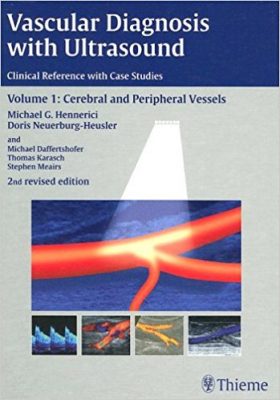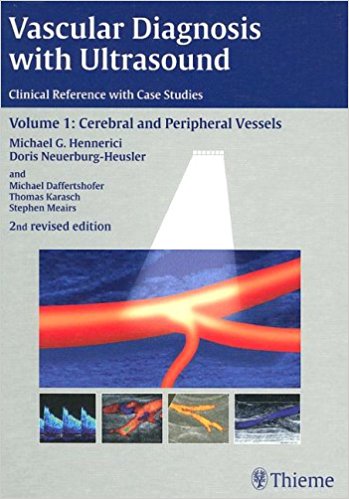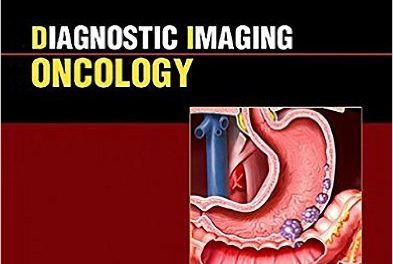 Volume 1- Cerebral and Peripheral Vessels, 2nd revised edition
Volume 1- Cerebral and Peripheral Vessels, 2nd revised edition
(Volume 2 is Abdominal and Renal Vessels)
Editors: Michael G. Hennerici, MD; and Doris Neuerburg-Heusler, MD
Contributors: Michel Daffertshofer, MD; Thomas Karasch, MD; and Stephen Meairs, MD
Publisher: Thieme – 366 pages, with 532 illustrations and 49 tables
Book Review by: Nano Khilnani
The diagnosis and treatment of diseases in vessels has undergone significant progress since noninvasive ultrasound technologies were introduced in the 1970s. Today, with ultrasound, we can detect early silent stages of atherogenesis as well as the morphological features of advanced atherosclerosis during its progression and regression in all major arteries in the body, the editors point out in their Preface.
Ultrasound today not only enables us to visualize arterial and venous thrombosis but also detect and quantify circulating microemboli. Individual patient diagnostic monitoring through ultrasound technologies also enable us to do randomized clinical trials to gather important data for evidence-based medicine.
Such data helps us detect potential heart attack and “brain attack” victims both in advanced and developing countries as well, the editors point out.
They write: “Increasing age combined with unfortunately remaining high prevalences and incidences of myocardial infarction, stroke and peripheral vascular disease underline the need for early identification of subjects at high risk for in a yet asymptomatic period with potential therapeutic impact in primary prevention, and for means to improve monitoring for secondary prevention.” They point out these three distinct advantages of ultrasound technology:
- Non-invasive
- Always available
- Economically viable
The first edition of this book was published in German language in 1988, and it was widely welcomed by both novice and experienced sonographers because of its strict illustrative composition. A major revision of that German edition was published in 1994.
This first English edition of this book appeared in 1998 and what you are holding is the second English that was published in 2006. The editors have organized its contents around seven chapters as shown below:
- Physics and Technology of Ultrasound
- Extracranial Cerebral Arteries
- Intracranial Cerebral Arteries
- Cerebral Veins
- Peripheral Arteries
- Peripheral Veins
- Case Histories
- Glossary
Let us take a look at the broad outline of topics in chapter 3 – Intracranial Cerebral Arteries, to see what types of content you will find within the chapters:
- Examination
- Special Equipment and Documentation
- Examination Conditions
- Functional Tests
- Normal Findings
- Principle
- Anatomy and Findings
- Evaluation
- Sources of Error
- Pathological Findings
- Principle
- Findings
- Evaluation
- Sources of Error
- Special Applications
- Diagnostic Effectiveness
- References
This chapter and the entire book is amply illustrated, making it easier for you to learn and retain the information contained within. A good number of ultrasound images are presented to enable you to view the diseases and disorders in the arteries and veins of the patients.
The sonographs provide views with and without contrast media. Large detailed drawings of various arteries and veins further enhance your learning and understanding of the anatomy and physiology.
Some of the important features of this book are:
- Comprehensive coverage of vascular ultrasonography in the arteries and veins of the cerebral circulation and the peripheral upper and lower limb circulation.
- Systematic presentation of all available ultrasound technologies – including continuous and in frequency and amplitude power modes pulsed-wave Doppler mode, B-mode. conventional and color-coded duplex analysis in frequency and amplitude power modes.
- In-depth chapters on anatomy and physiology, normal and abnormal findings, test accuracy and sensitivity.
- Helpful information with data from other diagnostic methods (e.g. conventional and non-invasive MR angiography) used in each region, as well as authoritative assessments of recent developments in ultrasound technology, such as tissue perfusions studies, 3D and 4D imaging, contrast enhancement, and micro-bubble applications and their diagnostic and therapeutic implications (sonothrombolysis and thrombus micro-fragmentation).
- A revised section with many new, challenging case studies for review both for the novice and the expert in the field.
All in all, this is an excellent book on diagnosing diseases, disorders, abnormalities, and anomalies within vessels through the use of various ultrasound technologies. The editors and authors have done an outstanding job.
Editors:
Michael G. Hennerici, MD, PhD is Professor and Chairman of the Department of Neurology at the University of Heidelberg Klinikum Manheim in Manheim, Germany.
Doris Neuerburg-Heusler, MD is former Director of the Department of Noninvasive Diagnostics at Aggertalklinik, Engelskirchen, in Cologne, Germany.
Contributors:
Michel Daffertshofer, MD, PhD is Associate Professor in the Department of Neurology at the University of Heidelberg Klinikum Manheim in Manheim, Germany.
Thomas Karasch, MD is with the Department of Cardiology /Angiology at the University of Cologne in Cologne, Germany.
Stephen Meairs, MD, PhD is Associate Professor in the Department of Neurology at the University of Heidelberg Klinikum Manheim in Manheim, Germany.







